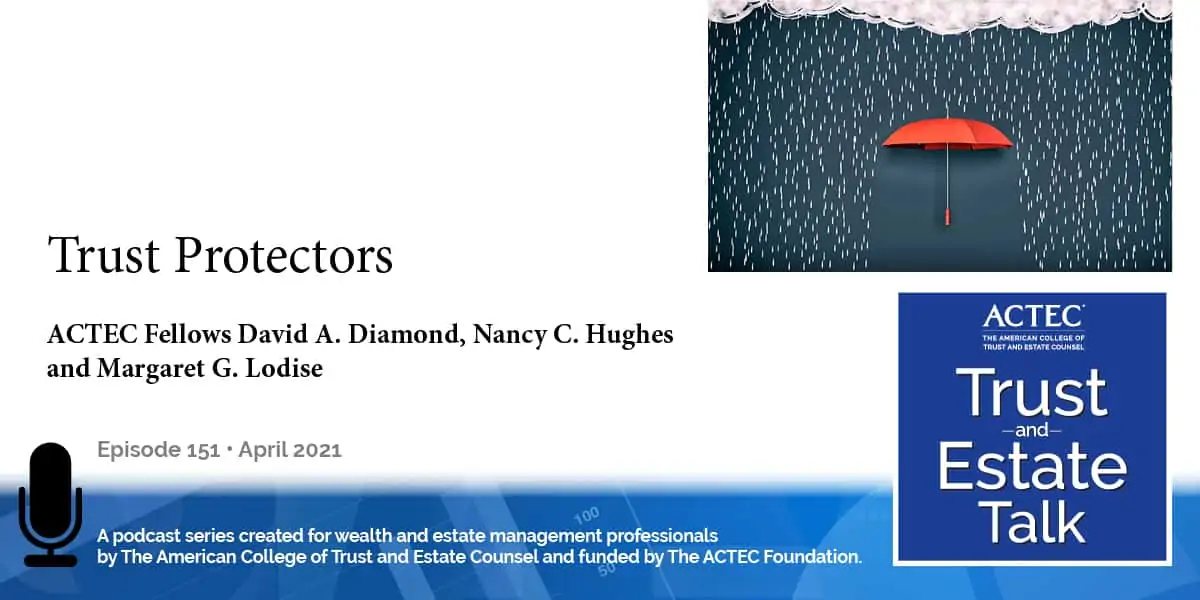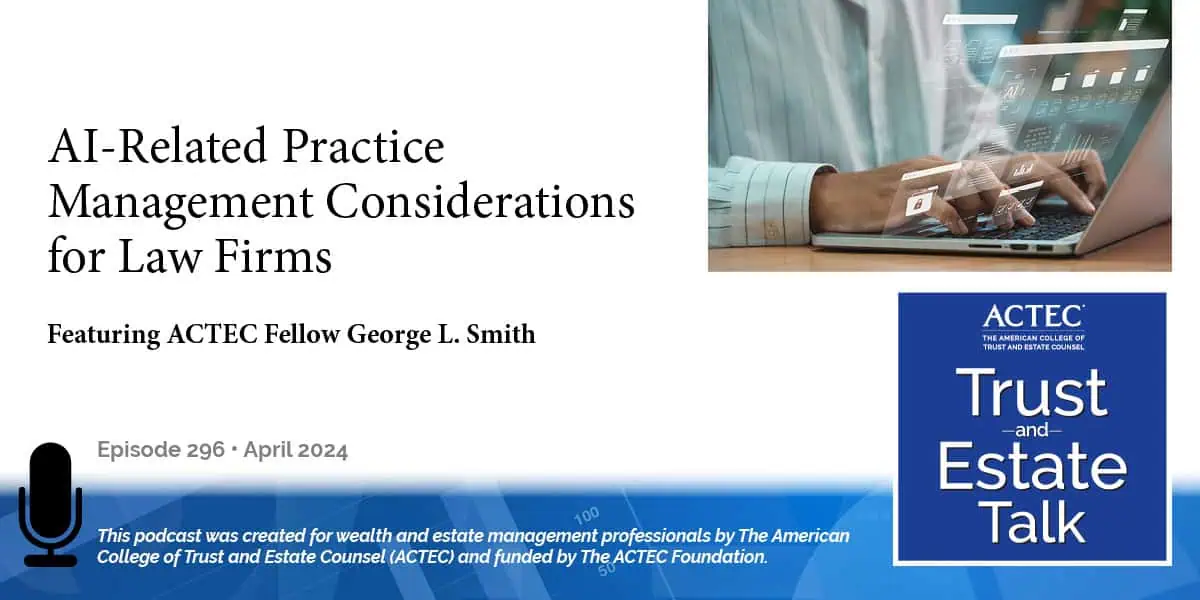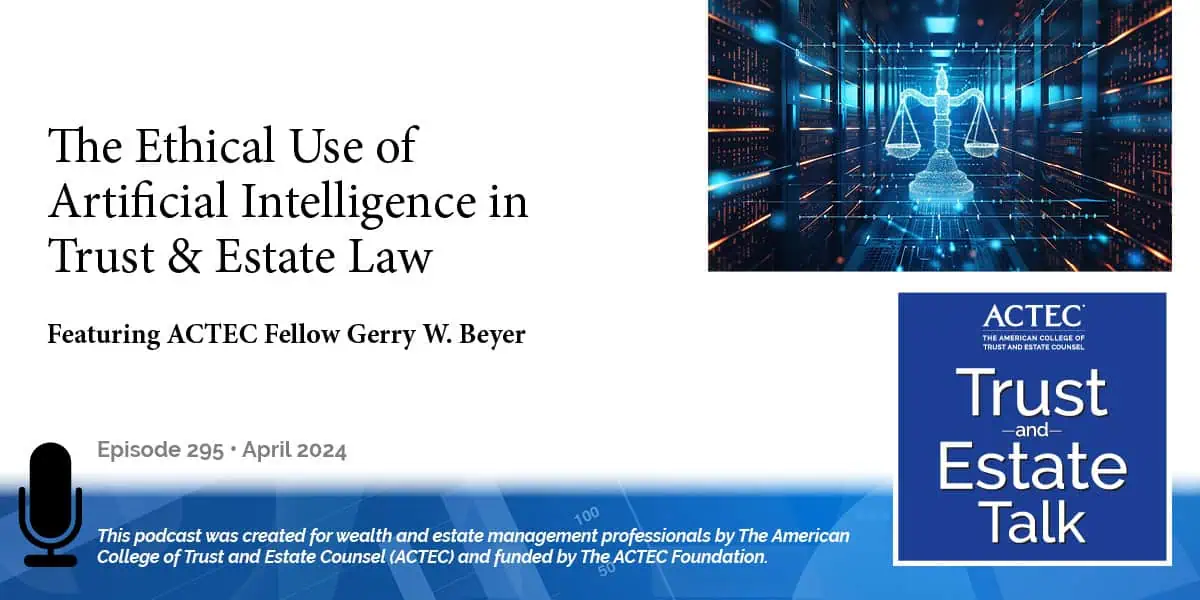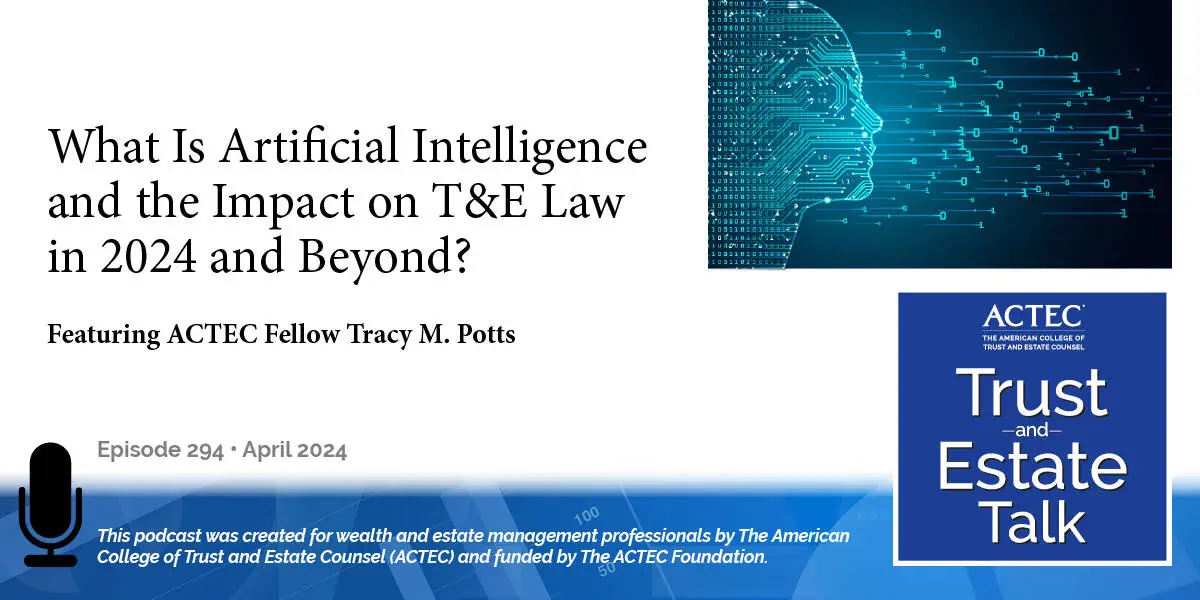Trust Protectors

“Trust Protectors,” that’s the subject of today’s ACTEC Trust and Estate Talk.
Transcript/Show Notes
This is Jean Gordon Carter, an ACTEC Fellow from Raleigh, North Carolina. Trust protectors are relatively recent innovations in trust law but they are becoming more and more popular, especially in dynasty trusts and other long-term irrevocable trusts. To educate us today on trust protectors you will be hearing from ACTEC Fellows David Diamond of Wilmington, Delaware, Nancy Hughes of Birmingham, Alabama, and Margaret Lodise of Los Angeles. Welcome, in the order they’ll speak, Nancy, Dave, and Meg.
Planning Trust Protectors
This is Nancy. I come at this from a planning perspective. And as Jean mentioned, there are a lot of reasons to use trust protectors, especially in the dynasty trust context. And what we’re looking for is we really sort of need somebody to be the handy person to fix a trust that has some flaws in it. What’s surprising to a lot of people is we’ve used these sorts of mechanisms for a long time. We just didn’t call them trust protectors.
We frequently have given trustees the ability to amend a trust, to correct the defect that holds S stock. We’ve given a trustee the ability to amend a a trust to comply with the charitable trust role. We’ve named investment advisors, distribution advisors, and we frequently have given powers of appointment to holders. All of those techniques are things that go into the trust protector concept. And so, just get used to the idea that we’ve been doing this. We just didn’t call it that.
What I like the best in this world is giving an unrelated third party a lifetime special power of appointment to appoint to a class of people or charity in trust or outright in a nonfiduciary capacity. And what I mean there is, by doing this you can have the layperson’s ability to decant a trust, rewrite a whole trust and exercise the special power of appointment, into a new trust without ever having exercised any discretion and with minimal risk. Additionally, by having an unrelated third party hold this power, you can achieve grantor trust status under the income tax rules under 674 of the Code.
Additionally, another technique is to give an unrelated third party expansive powers. Ability to do things like direct the trustee to hold a concentrated position of stock. Direct the trustee to sell closely held stock. Direct the trustee to make a large distribution. If I give that to a third party, I would like to give that in a fiduciary capacity so that the trustee feels comfortable taking the direction. Ideally, in the right circumstance, I would do both. I would have a nonfiduciary, one person or entity, holding that limited power or special power and I would have another unrelated person in the fiduciary capacity holding those expansive powers.
Finally, one thing we want to mention is that you want to build in a succession of trust protectors or a mechanism so the vacancy, if there is a vacancy in the office, because we are looking at dynasty trusts. And, with that, I’ll turn it over to Dave.
Trustee’s Role in Trust Protectors
Thank you, Nancy. And I’m going to talk about the trust protector from the point of view of the trustee. And I’m with a corporate fiduciary. So, although my comments are those of a corporate fiduciary, I think the comments will really relate to any trustee relationship.
So, I think the question is, what is a trust protector used for from the trustee’s point of view? And there’s just a series of powers that you’ll find in state statutes and also in trust instruments. But the ones that you see very frequently are the power to modify the trust, powers related to quiet trusts, powers that trustees might not prefer to have. And then also powers related to income tax provisions. So, if we talk about powers to modify the trust, this is going to be – if you have a trust protector written into a document, it’s very likely that you’re going to have this – the power to modify. That the trust protector will have that power.
Usually, it’s the power to modify administrative and tax matters, but it might be more expansive. But generally, statutes and trust instruments provide the trust protector with the power to make modifications for administration reasons and tax matters. And I think more and more we’re seeing this become a little more flexible even to some documents having the ability to modify a trust for changing beneficial provisions. And this has become something that we’re seeing requested more and more in recent years.
The other powers that come up are powers that trustees might prefer not to have. Maybe change of situs of the trust (Situs and the Resident Trust). Determining the compensation of the other parties, like the advisors for the trust. Hiring and firing other parties to the trustee advisors. Sometimes a given risk profile of a trustee, especially if it’s a corporate trustee, just might prefer or might make it that the trustee would prefer not to have those powers. It is great to have the trust protector in that role to be able to take those.
And then, a very utilitarian power that you see with trust protectors are powers for grantor trust status (Grantor Trusts: Tax Returns, Reporting Requirements and Options). The ability to turn off the grantor trust status. And by utilitarian, I mean that it’s there for specific use; and the idea is that if the grantor has the power to substitute assets, the trust protector will usually have the power to terminate that power. So, that is often seen in trust instruments as well, if it’s a grantor trust.
My last point before I turn it over to Meg is that the question often comes up as to whether the party is a fiduciary or not a fiduciary – whether the trust protector is a fiduciary or not a fiduciary. And I would say that if the trust protector is directing the trustee on any matters, it should be done in a fiduciary capacity as a going proposition.
And, in general, we usually see trust protectors acting in fiduciary capacities, unless there are certain powers that are better done not in fiduciary capacities. Maybe adding a beneficiary or deleting a beneficiary. Or maybe there’s just a very specific fact pattern that makes it harder to say that this person could be doing it in a fiduciary capacity. So, with that, let me turn it over to you, Meg.
Trust Protectors and State Law
Thanks, Dave. Speaking of fiduciary capacities, I want to focus a little bit on, first of all, the variety between states. Not all states have statutes regarding trust protectors, but even the states without statutes appear to recognize that their trust protectors exist through case law. A good example of this is the Robert T. Maclean irrevocable trust v. Patrick Davis, which is a Missouri case which deals with whether or not a trust protector exists even if the statute does not provide for it.
Where statutes do exist, they usually provide direction as to whether a trust protector is considered a fiduciary or not with reference to what Dave was just talking about. But even where the statute provides such direction, a trustor can change that provision by the terms of the trust. Case law on trust protectors is relatively sparse. In the years between 2016 and ’21 there were about two dozen cases specifically referencing trust protectors throughout the country. And interestingly enough, not many of those cases even focus on the issue of whether or not a trust protector is a fiduciary.
However, you can generally ascertain from the cases that the courts are following case law in the fiduciary field in general, in that where the court believes that there has been a breach or a potential breach, and therefore damage to a beneficiary’s interest, the court will look to find a way to assign liability regardless of specific provisions of the trust. Now, there are states where the law defers to the trustor intent significantly, such as Delaware, and those states are more likely to follow the terms of the trust.
But as with any drafting, it’s important to consider not just the language that is used, but the specific facts and circumstances as the court is going to wind up looking to determine the respective rights of the various parties and will look to the underlying effects rather than to the name that’s been assigned to a particular role. So, merely calling somebody a trust protector and saying that the trust protector is not acting in a fiduciary role will not allow you necessarily to circumvent state law if what the trust protector is doing is acting like a fiduciary.
The other important factor to consider is that no matter how well drafted a trust protector provision may be in a trust to give the trust protector the ability to fulfill the trustor’s intent, the court may still not be able to allow the trust protector to do that in light of state law. A good example of this is a Florida case of Minassian v. Rachins, which has both the 2014 and 2018 appellate recorded opinion where the court ultimately concluded that it was very clear what the trustor intent was; but the court felt it was not able to fulfill the trustor’s intent because of the implications of state law.
Another example where the court did not, apparently, allow the trust protector to follow what were the evident wishes of the settlor was the Matter of Trust for the Benefit of Hettrick, which was a New York case from 2018 where the trust protector attempted to remove the trust from the jurisdiction of New York to Virginia and the court found that it would not allow that move to happen, despite the terms of the trust.
So, the bottom line is that as with most fiduciary issues, the courts will do what they believe is important in connection with upholding trustor intent, but also upholding public policy and the rights of the beneficiaries. So, you should always draft with an eye to making sure that your beneficiaries still are protected and that the trust protector has a role that is compliant with the state law that you’re drafting in. And that’s it.
Well, thank you all for teaching us and explaining to us the benefits and pitfalls of trust protectors.
This podcast was produced by The American College of Trust and Estate Counsel, ACTEC. Listeners, including professionals, should under no circumstances rely upon this information as a substitute for their own research or for obtaining specific legal or tax advice from their own counsel. The material in this podcast is for information purposes only and is not intended to and should not be treated as legal advice or tax advice. The views expressed are those of speakers as of the date noted and not necessarily those of ACTEC or any speaker’s employer or firm. The information, opinions, and recommendations presented in this Podcast are for general information only and any reliance on the information provided in this Podcast is done at your own risk. The entire contents and design of this Podcast, are the property of ACTEC, or used by ACTEC with permission, and are protected under U.S. and international copyright and trademark laws. Except as otherwise provided herein, users of this Podcast may save and use information contained in the Podcast only for personal or other non-commercial, educational purposes. No other use, including, without limitation, reproduction, retransmission or editing, of this Podcast may be made without the prior written permission of The American College of Trust and Estate Counsel.
If you have ideas for a future ACTEC Trust & Estate Talk topic, please contact us at ACTECpodcast@ACTEC.org.
© 2018 – 2024 The American College of Trust and Estate Counsel. All rights reserved.
Latest ACTEC Trust and Estate Talk Podcasts

AI-Related Practice Management Considerations for Law Firms
A discussion for law firms about how to incorporate AI in their practice management, including staff considerations, the “billable hour,” and more.

The Ethical Use of Artificial Intelligence in Trust & Estate Law
A law professor offers insights into the risks, rewards, duties and ethical considerations of lawyers using AI in their T&E practices.

What Is Artificial Intelligence and the Impact on T&E Law in 2024 and Beyond?
A primer on the types and uses of AI, then a deeper dive into the impact on trust and estate law from types to applications to ethical considerations.

